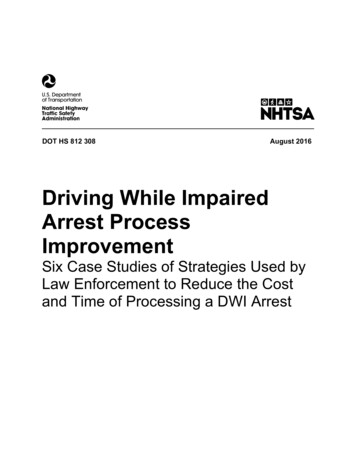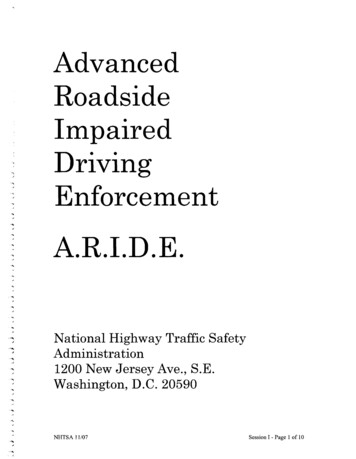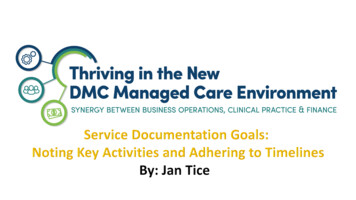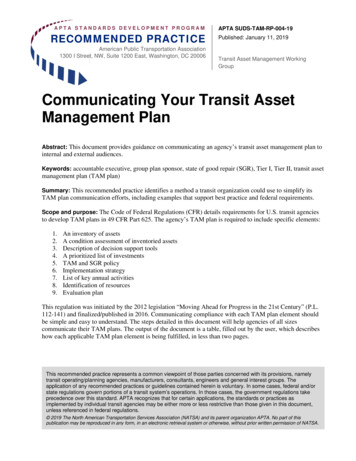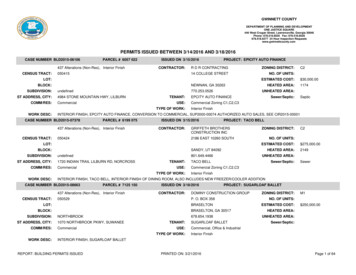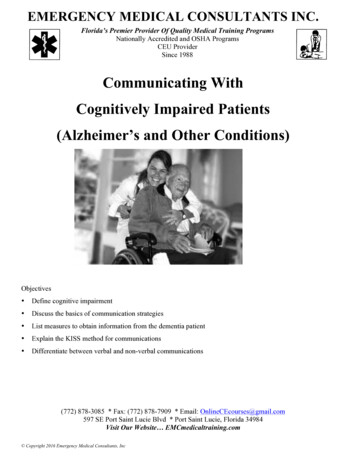
Transcription
EMERGENCY MEDICAL CONSULTANTS INC.Florida’s Premier Provider Of Quality Medical Training ProgramsNationally Accredited and OSHA ProgramsCEU ProviderSince 1988Communicating WithCognitively Impaired Patients(Alzheimer’s and Other Conditions)Objectives Define cognitive impairment Discuss the basics of communication strategies List measures to obtain information from the dementia patient Explain the KISS method for communications Differentiate between verbal and non-verbal communications(772) 878-3085 * Fax: (772) 878-7909 * Email: OnlineCEcourses@gmail.com597 SE Port Saint Lucie Blvd * Port Saint Lucie, Florida 34984Visit Our Website EMCmedicaltraining.com Copyright 2016 Emergency Medical Consultants, Inc
Health care workers frequently encounter individuals who are cognitively impaired, Cognitive impairmentsaffect the ability to think, concentrate, formulate ideas, reason and retain information. Although oftenassociated primarily with old age, cognitive decline may occur due to a variety of reasons such as:ü ü ü ü ü ü Alzheimer’ diseaseCVA (stroke)Delirium – often caused by infections, electrolyte imbalances, brain anoxiaBrain trauma – can happen at any ageDevelopmental disorders – mental retardation, autism, learning disabilitiesDementia – the word that describes the collection of symptoms outlined belowThe signs of cognitive impairment include memory loss, changes in behavior or personality, loss ofjudgment or the ability to make decisions and other communication difficulties. When a person suffers fromcognitive impairment it can be challenging to communicate effectively with them. As healthcare workers, itis very important that we are able to have the patience, understanding and skills to provide quality care tothose individuals who are affected by cognitive impairment.Communication Challenges: They may have a limited attention span and may find it difficult to follow long conversations. Keeptopics in the KISS format: Keep It Short and Simple. Try to avoid conservations that go into detail, andtry to avoid difficult vocabulary. This will help patients to understand, and in turn, respond moreappropriately. They may attempt to describe an object that they cannot name or create a word to describe the object. They may only be able to focus on one thought at a time, so multiple step instructions may lead toconfusion. Give them time to complete one step at a time, before moving on to the next step. They may exhibit short term memory problems, which in turn, affects their train of thought - or to repeatthoughts again and again. They may quickly forget what they did understand at the beginning of theconversation. They may be affected by background distractions such as a television, noise or nearby conversations,which can compete for attention and impair conversations and communication.They may need much more time than the average person to respond to a question. Staff and familycaregivers must be patient, allowing the patient enough time to process questions and formulateresponses. They may have communication challenges with resulting frustrations, which often cause many of thenegative behaviors that commonly occur in a person with dementia. They may have additional hearing or visual difficulties that affect their communication ability.Communication: Focusing on Abilities: People who suffer with dementia are people with individual needs and wants. Furthermore, the diseaseprogression associated with dementia occurs at a different rate for each person. The staff, and familycaregivers must be flexible with their communication techniques; adapting their strategies to reflect eachperson’s changing cognitive level and need. Persons with dementia will often communicate to family and staff through their behaviors andexpressions of emotion.
In order to improve communication with a person who has dementia, staff and family caregivers must becreative listeners, and adapt communication strategies to meet each person’s unique needs. Both verbaland nonverbal communication should be used.Examples of non-verbal communications include: Shaking handsProviding eye contactHuggingSmilingTouching gesturesVerbal communications include: Giving feedbackInitiating a conversationAsking questionsGiving instructionsStorytellingSingingCommunication Strategies: Helping the Person with Dementia Communicate: Self-expression is vital to a person’s well being. Every effort should be made to show interest in whatthe person with dementia is attempting to communicate. Never interrupt a person who has dementia when he or she is trying to communicate an idea - thisdistraction may cause them to lose their train of thought. It may be helpful to supply a word that theperson with dementia is struggling to find. Eye contact (nonverbal communication) and following with an acknowledgement (verbalcommunication) are excellent methods to let a person know their thoughts are being heard. The blendingof nonverbal and verbal communications is very beneficial. Never contradict or argue with a person with dementia because this may lead to a catastrophic reactionsuch as yelling, crying or striking out. Staff must be sensitive to the limited understanding andcomprehension of that person. Look at the emotional meanings and subtexts behind statements made by a person with dementia. Forexample, a person waiting for their mother may most likely be feeling lonely, insecure and fearful.
Communication Strategies: Helping the Person with DementiaUnderstand You: It is critical to get a dementia patient’s attention before sayinganything to them, staff and family caregivers should begin aconversation by making eye contact. It is also important to identify yourself and call the person by name. Staff and family caregivers need to speak slowly and clearly, and in alow pitched voice, while maintaining an open, calm and friendlycommunication manner. It is important to remember to break down tasks into clear and simple steps. Staff and family caregivers must also be aware of what words are familiar to the person and rememberto use them often. Using words from a person’s native language can be extremely helpful incommunication efforts. When communicating with a person who has dementia, avoid open ended questions. Offer yes or noquestions. Or provide a choice limited to no more than two items - anything more will cause furtherconfusion. If a person with dementia does not understand the question, repeat it or rephrase it. Sometimes thepatient may reply appropriately if they have a better understanding of the question. Persons with dementia need more time than the average person to process a question and may requireextra time and patience to respond. Most importantly, simple expressions of caring communicate to any person that they are loved andappreciated. A smile or a hug speaks volumes to a person with dementia.Communicating With a Person Who Has Dementia:A person with memory loss and confusion may have trouble understanding what is said, or saying what heor she thinks and wants. This can be very frustrating for both the person with dementia and his caregiver.Following are some practical tips to help make communicating easier:1. Personalize your Conversation: Use the person's name to get his attention. Talk to the person directly,make eye contact. Try a gentle touch on the arm to help him focus on the conversation. Speak on a topic thatboth the speaker and patient express an interest in.2. Use Short, Simple Sentences: Keep sentences short and easy to understand. Speak clearly and slowly.This allows for better comprehension.3. Repeat Sentences Exactly: If the person does not seem to understand a word, try substituting anotherword that will convey the same meaning. Repeat what you are saying, using the same words, gestures andtone of voice.
4. Be Specific: Say “Here is your oatmeal”, instead of, “It's time for breakfast”. Or try; “Do you want yourglasses?” instead of “Do you want these?” Avoid the phrase, “Don't you remember?”5. Offer Simple Choices: Ask questions that require a yes or no answer. Limit the number of choices in aquestion “Would you like a cup of tea?” instead of, “Would you like something to drink?” When givinginstructions to a patient, only one step at a time should be given, allowing for comprehension andunderstanding.6. Use Labels: Label frequently-used-items with a picture (e.g. a toilet on the bathroom door or cups on acupboard door).7. Use Signals Other than Words: Use Non-Verbal Communications/Universal signs Wave or gently touch the person’s arm to say hello Smile and nod to show you understand what is being said Motion with your hand to invite him to join in an activity Show the person what you are talking about(ie, point to a glass when asking if he wants a glass of water) Use touch when the person is upset Watch and listen for clues in behavior.(Wandering can often mean the person needs to use the toilet) Be aware of your body language - facial expression, tone of voice and posture. The person may notunderstand the content of what you are saying but he will understand your non-verbal signals8. Try to Determine What is Really Being Said: Stop talking and listen to what the person is saying. Repeatwhat you hear “You're hungry now, aren't you?” Think about what the person really means; “I want to gohome” may mean “I'm anxious and need reassurance.” Recognize the tone as well as the words. Give theperson time to answer. Offer support even when you do not understand him.9. Reduce Distractions: Communicate in a calm, quiet environment where the person will not be distractedby other activities. Encourage the person to wear his glasses and hearing aid. Provide the conversation atface level. (Approach from the front, do not surprise the patient from behind).10. Have Patience: Impaired patients can be time-consuming; they do not know they are repeatingthemselves. This may take a toll on the provider, yet the provider should remain calm without gettingfrustrated.Pain is another area that may alter mental capacity. Treating pain in patients with cognitive impairment is adifficult task for a very simple reason: communication. Dementia patients may not be able to communicatefully about their pain due to their cognitive impairment. Depending on the degree of impairment, the personmay not be able to say where it hurts or even that pain is present.
The most important factor, when determining pain, is flexibility and persistence in finding the scoringmethod most appropriate for the individual patient. Depending on their own cognitive abilities, somepatients may respond better to a numeric scale (0-10 scale), some may do better with words (no pain, mildpain, moderate pain, severe pain), and others may prefer an instrument based on faces. (See chart)Pain Scale:Allows the patient to describe the presence and intensity of pain:None (0)Mild (1-3)Moderate (4-6)Severe (7-10)Pain Faces Scale:Some characteristics of pain that healthcare providers should keep in mind are: Pain is the fifth vital sign Assessing pain in an impaired person is not an easy task. Look for non-verbal cluesActivity changes – excessive sleeping, personality changes. Moaning/grimacingIf in doubt, assume that it hurtsIt is not just how severe their pain is; it is how that pain impacts their quality of life that should be ofconcernConclusion:Providing care to cognitively impaired individuals is not an easy task. It is frustrating to have to deal with awide range of behavioral issues day after day for a long period of time. Dealing with these individuals cancause healthcare workers to become “burned out” from excessive stress related to the responsibility ofmeeting the needs of these challenging patients. Healthcare workers should be aware of their own limits andneed to seek help when the demands become overwhelming by voicing their feelings of frustration andstress to their supervisor so that assignments can be shifted or shared to utilize the best source of healthyresource for the client. And while providing care to cognitively impaired people can be one of the mostchallenging situations in healthcare, it can also be one of the most rewarding.
Additional resources can be found at:Alzheimer's Association225 North Michigan Avenue, Floor 17Chicago, IL 60601-76331-800-272-3900 (toll-free)www.alz.orgAlzheimer's Disease Education and Referral (ADEAR) CenterP.O. Box 8250Silver Spring, MD 20907-82501-800-438-4380 (toll-free)www.nia.nih.gov/alzheimersAlzheimer's Foundation of America322 8th Avenue, 7th FloorNew York, NY 100011-866-232-8484 (toll-free)www.alzfdn.orgAmerican Stroke Association(Division of American Heart Association)(800) 553-6321http://asa.healthology.comBrain Injury Association(800) 444-6443www.biausa.orgCaregiver Resource efam.aspChildren of Aging ParentsPO Box 7250Penndel, PA 19047(800) 227-7294www.caps4caregivers.orgFamily Caregiver Alliance785 Market Street, Suite 750San Francisco, CA 94103(415) 434-3388(800) 445-8106
Eye contact (nonverbal communication) and following with an acknowledgement (verbal communication) are excellent methods to let a person know their thoughts are being heard. The blending of nonverbal and verbal communications is very beneficial. Never contradict or argue with a person with dementia because this may lead to a catastrophic reaction such as yelling, crying or
